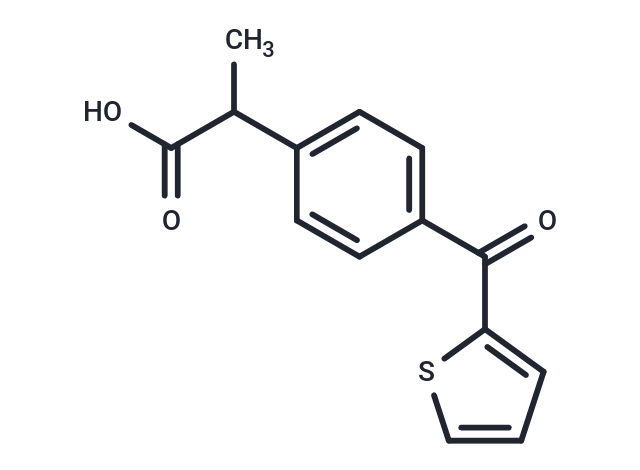Shopping Cart
Remove All Your shopping cart is currently empty
Your shopping cart is currently empty
Suprofen (Suprol) is an IBUPROFEN-type anti-inflammatory analgesic and antipyretic. It inhibits prostaglandin synthesis and has been proposed as an anti-arthritic.

| Pack Size | Price | USA Warehouse | Global Warehouse | Quantity |
|---|---|---|---|---|
| 5 mg | $35 | In Stock | In Stock | |
| 10 mg | $59 | In Stock | In Stock | |
| 25 mg | $113 | In Stock | In Stock | |
| 50 mg | $198 | In Stock | In Stock | |
| 100 mg | $372 | In Stock | In Stock | |
| 500 mg | $896 | In Stock | - | |
| 1 mL x 10 mM (in DMSO) | $39 | In Stock | In Stock |
| Description | Suprofen (Suprol) is an IBUPROFEN-type anti-inflammatory analgesic and antipyretic. It inhibits prostaglandin synthesis and has been proposed as an anti-arthritic. |
| In vitro | Suprofen inactivates the diclofenac-4-hydroxylase activity of baculovirus-expressed P450 2C9 in a time- and concentration-dependent manner, which is consistent with mechanism-based inactivation. [1] Suprofen is a known generator of singlet oxygen whose participation in the reaction is supported by the effects of quenchers and scavengers. Suprofen photosensitizes the production of alkali-labile cleavage sites in DNA much more efficiently than direct strand breaks. [2] Suprofen sensitizes photo-oxidation of cholesterol, producing 7 alpha- and 7 beta-hydroperoxides but not 5 alpha-hydroperoxide of cholesterol. Suprofen-sensitized photo-oxidation of membrane lipids of liposomes increases leakage of trapped glucose, suggesting photosensitized destabilization of the membrane structure. [3] Suprofen incorporation in the phosphatidylcholine (PC) evaporation vesicles (REV) membrane leads to approximately 5% increase in the encapsulation efficiency (34%) in comparison to standard REV (29%). [4] |
| In vivo | Suprofen combined with PGF2 alpha blocks induction of uterine contractions, suggesting the possibility that Suprofen also antagonizes PGF2 alpha receptor binding. [5] Suprofen are effective at preventing BAB disruption after paracentesis in dogs, indicating their potential usefulness for treatment of prostaglandin-mediated ocular disease. [6] Suprofen (3.7 mg/kg, i.v.) induces a marked decrease in the firing evoked in arthritic rats by ankle mobilization. [7] |
| Synonyms | TN-762, Suprol, Profenal, Maldocil |
| Molecular Weight | 260.31 |
| Formula | C14H12O3S |
| Cas No. | 40828-46-4 |
| Smiles | CC(C(O)=O)c1ccc(cc1)C(=O)c1cccs1 |
| Relative Density. | 1.2959 g/cm3 (Estimated) |
| Color | White |
| Appearance | Solid |
| Storage | Powder: -20°C for 3 years | In solvent: -80°C for 1 year | Shipping with blue ice/Shipping at ambient temperature. | |||||||||||||||||||||||||||||||||||
| Solubility Information | DMSO: 50 mg/mL (192.08 mM), Sonication is recommended. | |||||||||||||||||||||||||||||||||||
| In Vivo Formulation | 10% DMSO+40% PEG300+5% Tween 80+45% Saline: 2 mg/mL (7.68 mM), Sonication is recommended. Please add the solvents sequentially, clarifying the solution as much as possible before adding the next one. Dissolve by heating and/or sonication if necessary. Working solution is recommended to be prepared and used immediately. The formulation provided above is for reference purposes only. In vivo formulations may vary and should be modified based on specific experimental conditions. | |||||||||||||||||||||||||||||||||||
Solution Preparation Table | ||||||||||||||||||||||||||||||||||||
DMSO
| ||||||||||||||||||||||||||||||||||||
| Size | Quantity | Unit Price | Amount | Operation |
|---|

Copyright © 2015-2026 TargetMol Chemicals Inc. All Rights Reserved.